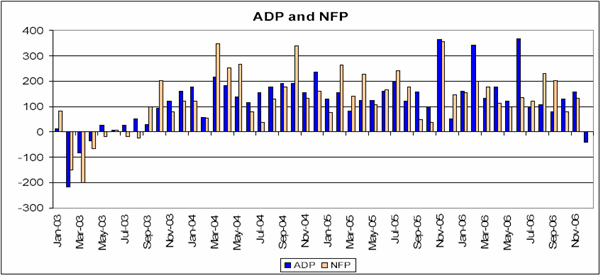We are expecting the December Non-farm payrolls report tomorrow morning and now more than the ever the amount of jobs added or subtracted by US corporations last month could determine where the US dollar is headed next. After having sold off significantly at the end of November, the US dollar is on its way to recuperating all of its losses. Whether it is able to do take the EUR/USD below 1.30 will be dependent on if we see a sub 50k print in payrolls. With a skyrocketing stock market at the end of 2006 and low oil prices, the negative ADP print caught the market off guard along with the weakness in the other employment reports that followed. This surprise has forced many banks to lower their NFP forecasts, but before becoming too concerned, there are many reasons why payrolls could remain positive. As usual, non-farm payrolls is one of the most market moving indicators for the US dollar and the level of payroll growth in the economy last month will help to determine if a soft landing scenario is in full play.
Examining the NFP Leading Indicators
Arguments for a Sub 100k Print
- First Negative ADP Since April 2003
- Drop in Monster.com Employment Index
- Drop in Hudson Employment Index
- Employment Component of Manufacturing ISM Remains Contractionary
- Payrolls Derivatives Auction Settles at 82.2k
There are number of “leading indicators†for the non-farm payrolls report that we watch very closely and most of them paint a very grim picture of the labor market. The biggest surprise was the 40k drop in the ADP survey. Even though the ADP survey has had a poor track record of forecasting the absolute number of payrolls, it has had a very good track record in forecasting the direction of payrolls. Since January 2003, there have only been 3 months where the ADP report forecasted an increase in jobs while non-farm payrolls actually dropped in the same month and that was over 3 years ago (as shown in the chart below). In addition, the Hudson Employment Index posted a 2.6 percent drop while the Monster.com employment index fell 8 points in the month of December. The employment component of the manufacturing ISM report also points to another month of job losses in the manufacturing sector. As a result, the payrolls derivative auction indicates that traders are expecting jobs to increase by only 82.2k, which compares to the market’s downwardly revised forecast of 100k.

Not Bad Enough for a Negative Payrolls Report
However, even though the ADP report has done a great job of forecasting the directionality of payrolls, the December NFP may actually buck the trend and remain positive. The following factors support a positive reading:
- Jobless Claims Improved in December
- Employment Component of Service Sector ISM Accelerated
- Challenger Reports a Drop in Layoffs
- Mild Weather Should Prolong Construction Projects
Jobless claims for the month of December averaged at 314k, which was less than the 327k average in November and suggests that companies may not be firing aggressively enough to warrant a drop in overall payrolls. The US economy is also mostly service oriented and today’s service sector ISM report revealed an improvement in its employment component. The sub-index increased from 53.3 to 51.6, which indicates that companies in the service sector are continuing to add jobs. Finally, the planned job cuts according to employment consulting firm Challenger, Gray and Christmas fell by 29 percent in the month of December compared to the prior month. The mild weather should also keep construction programs going and delay any major layoffs in that sector. Therefore even though non-farm payrolls could easily come in below 100k, it should not be negative. We expect payrolls to be somewhere between 50k-70k.
What Is Expected
Here is what the market is currently expecting:
Change in Non-Farm Payrolls: 100k Forecast, 132k Previous
Unemployment Rate: 4.5% Forecast, 4.5% Previous
Change in Manufacturing Payrolls: -15k Forecast, -15k Previous
Average Hourly Earnings: 0.3% Forecast, 0.2% Previous
Average Weekly Hours: 33.9 Forecast, 33.9 Previous
If construction sector jobs do hold steady, then the biggest potential sector where job growth could be hit would be in the retailing sector. From the initial holiday retail sales reports, sales have been modest and weak job growth would explain the weakness in consumer demand.
What does this mean for the US Dollar?
For the US dollar, how non-farm payrolls fares will be extremely important. The EUR/USD is trading not far from its one month low while the GBP/USD has already broken that level. Both currency pairs are very vulnerable to a further correction after having broken through a trendline support. We would need to see job growth in excess of 100k to validate a push through 1.30 in the EUR/USD. If job growth is anywhere between 50-70k or less, the EUR/SUD could see a much needed bounce as the market begins to price in the possibility of weaker US growth in 2007. The labor market is the backbone of the US economy. Weak job growth poses a big threat to consumer spending. Even though the Federal Reserve is currently worried about inflation, at the rate that oil prices are moving lower, it should not remain a problem for long and growth will soon become the central bank’s bigger concern. However with both service and manufacturing sector ISM reports increasing in the month of December, if job growth surprises to the upside instead, economic fundamentals would support a continuation of 5.25 percent rates and a move below 1.30.
Kathy Lien is the Chief Currency Strategist at FXCM.